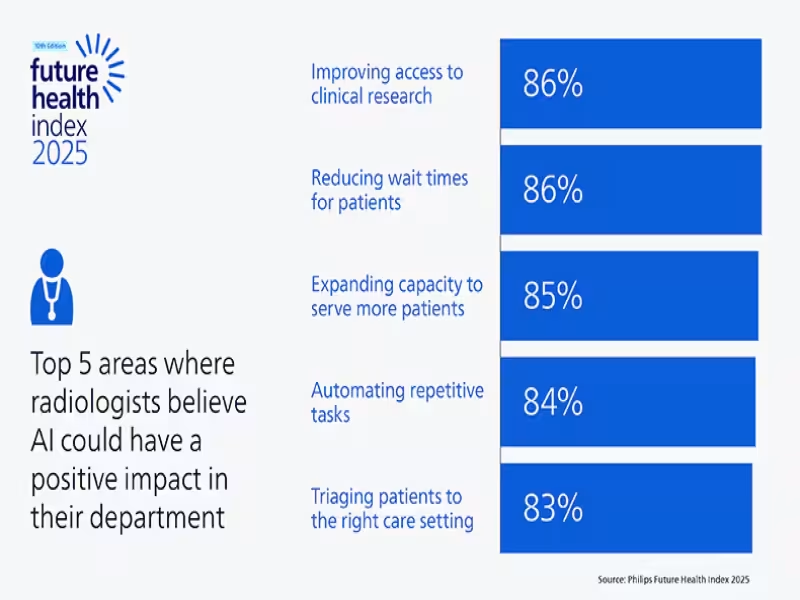
SHERIDAN, WYOMING - November 25, 2025 - In radiology, the most transformative AI of the coming decade may not be the algorithms that make headlines, but the ones that quietly shave minutes off every case, reduce clicks, and keep worklists flowing smoothly for overburdened imaging teams. That is the vision outlined by Shez Partovi, MD, Chief Innovation Officer and Chief Business Leader Enterprise Informatics at Philips, who argues that the future of AI in radiology is the AI you barely notice - deeply embedded into workflows rather than bolted on as yet another standalone tool.
From "Will it help?" to "How fast can you implement it?"
In conversations with health systems, the tone around AI in radiology has shifted dramatically. The questions are no longer "Will this help us?" or "Will it be worth the investment?" but increasingly "How fast can you implement it?" This reflects a growing urgency as radiology departments struggle to keep pace with rising imaging volumes and staffing pressures.
Debates over whether AI will replace radiologists have largely given way to a more pragmatic view: augmenting radiologists' expertise with AI is the only viable path to managing demand. Philips' 2025 Future Health Index shows that most radiologists (85%) are optimistic AI technologies could improve patient outcomes, compared to 78% of healthcare professionals overall. They see particular potential in automating repetitive tasks, expanding capacity, and improving triage, wait times, and throughput.
The integration gap: why workflow still matters most
Despite strong optimism, integration remains a critical bottleneck. Many tools and algorithms exist, but making them work in the "complex, dynamic, and sometimes messy world" of clinical practice is still a challenge. Radiologists consistently emphasize that they want AI inside the systems they already use, not as another application to manage.
Partovi likens the ideal to a pilot's cockpit, with all instruments visible in a single pane of glass. Radiologists, too, want everything in one view, seamlessly connected. Today, that is far from reality: Philips' Future Health Index indicates 60% of radiologists already spend too many clicks just to access necessary patient information, with 1 in 3 losing more than an hour during a typical shift. When AI is simply bolted on without regard for workflow, it can even increase workload instead of reducing it [1].
AI as a quiet co-traveler in daily radiology practice
The most successful AI deployments, Partovi notes, are those designed with radiologists rather than merely for them. When AI is embedded directly into existing visualization and reporting environments, it becomes a "co-traveler in the interpretive process," quietly supporting decisions without demanding extra attention.
At Hospices Civils de Lyon in France, Philips co-developed AI solutions that drastically reduced time spent on image contouring, all within the existing visualization workspace. One radiologist highlighted that every minute spent drawing measurement circles is a minute not spent on interpretation or patient interaction. In Brazil, at Fundação Instituto de Pesquisa e Estudo de Diagnóstico por Imagem, AI-generated insights appear directly within the diagnostic viewer, automatically prioritizing abnormal cases and shortening turnaround times. With AI supporting chest X-ray workflows, clinicians can receive results in as little as two minutes, enabling faster, more confident decisions and better patient care.
Beyond the interpretive moment: agentic AI takes on the "thousand little tasks"
The first wave of radiology AI concentrated on the interpretive moment: detecting fractures, bleeds, lesions and other findings. While such algorithms will continue to advance, Partovi points out that this is only a fraction of the radiologist's day. Much of their time is consumed by pre- and post-interpretive tasks: preparing cases, gathering priors, prioritizing worklists, reviewing reports, and coordinating follow-up.
Here lies the next major opportunity: agentic AI that can take on many of these "thousand little tasks" around the study, not just the interpretation itself. When entire diagnostic workflows are reimagined through an AI lens, even micro-gains in efficiency can compound into meaningful productivity improvements across the department. Over time, such AI agents will learn from user preferences, orchestrating protocols and workflows to anticipate what is needed next, surface the right information at the right moment, and direct attention to the most urgent cases.
Governance, liability and AI as part of the radiology team
As AI agents become full members of the radiology team, supervision and quality assurance must also evolve. Liability is a top concern: according to the Future Health Index, two-thirds of radiologists worry about it. Radiologists and administrators will remain accountable for final results, which means they will have to oversee AI agents much like attending physicians supervise residents.
Quality assurance will extend from people to algorithms, with continuous monitoring to detect AI model drift and performance issues. Partovi is already seeing customers validate AI tools in-house to ensure local effectiveness. Ongoing collaboration with regulators will be critical to establish standards around safety, accountability and continuous learning, especially as agentic AI systems grow more autonomous in managing workflow.
A future where AI's biggest impact is barely visible
Taken together, advancements in interpretive AI and agentic AI suggest a radically different future for radiology practice. Workflows will become more connected and efficient, allowing radiologists to concentrate on the interpretive moment where their expertise is irreplaceable. Yet, as Partovi emphasizes, this transformation may not feel dramatic day to day. Instead, it will "emerge almost unnoticed, as AI quietly takes its place alongside radiologists as a trusted co-traveler, automating the grunt work and extending their skills to deliver better patient care."
To discover what's next in AI in radiology and learn more about how Philips is advancing AI-powered precise diagnosis, visit the Philips RSNA 2025 event page at https://www.usa.philips.com/healthcare/event/upcoming/rsna.